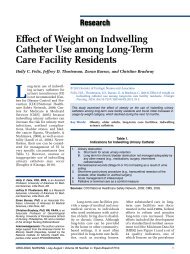Vaginal Support Pessaries: Indications for Use and Fitting ... - SUNA
Vaginal Support Pessaries: Indications for Use and Fitting ... - SUNA
Vaginal Support Pessaries: Indications for Use and Fitting ... - SUNA
You also want an ePaper? Increase the reach of your titles
YUMPU automatically turns print PDFs into web optimized ePapers that Google loves.
SERIES<br />
(see Figure 6). Compared to a<br />
Gellhorn pessary, a smaller size<br />
can be used; however, Cube use<br />
may also result in mechanical tissue<br />
injury. Cube pessaries are<br />
held in place because the concavities<br />
in the six sides allow vaginal<br />
tissue to con<strong>for</strong>m to the pessary<br />
shape. Because large amounts of<br />
epithelium are in contact with the<br />
pessary, drainage holes are important<br />
to allow desquamated cells<br />
<strong>and</strong> vaginal discharge to drain.<br />
The Cube is designed <strong>for</strong> self-care,<br />
but like the Gellhorn, some<br />
women <strong>and</strong> providers find it difficult<br />
to remove due to the suction.<br />
Softness <strong>and</strong> compressibility of<br />
the silicone used vary by manufacturer.<br />
Softer Cubes can be easier<br />
to insert, but firmer devices<br />
may be more likely to be retained,<br />
<strong>and</strong> choice is typically based on<br />
provider experience. The Cube<br />
pessary can be placed at different<br />
depths in the vagina, which may<br />
offer an advantage when a woman<br />
has an isolated or site-specific<br />
prolapse.<br />
Size is estimated by digitally<br />
measuring the diameter of the<br />
vaginal shaft <strong>and</strong> vault. To insert,<br />
lubricate the pessary <strong>and</strong> introitus,<br />
compress the pessary, part the<br />
introitus gently, <strong>and</strong> insert the pessary<br />
to the depth that best corrects<br />
the bulge <strong>and</strong> is most com<strong>for</strong>table<br />
<strong>for</strong> the patient. Com monly used<br />
sizes range from 1 to 4.<br />
To remove, lubricate the in -<br />
troitus, apply gentle traction on<br />
the pessary cord to stabilize <strong>and</strong><br />
bring the device toward the introitus,<br />
<strong>and</strong> then insert the tip of the<br />
index finger up above the Cube to<br />
release it <strong>and</strong> pull it gently out of<br />
the vagina. Pulling too hard on the<br />
cord alone will break the cord. If<br />
removal is difficult, a tenaculum,<br />
ring <strong>for</strong>ceps, pessary remover or<br />
crochet hook, or dental tape tied<br />
through several holes can be used<br />
to facilitate bringing the Cube to<br />
the introitus.<br />
Incontinence Pessary Options<br />
Incontinence pessaries help<br />
stabilize the urethra <strong>and</strong> the urethral<br />
vesicle junction to prevent<br />
leakage during times of increased<br />
abdominal pressure. Options<br />
include the Incontinence Ring or<br />
Dish, which are similar to regular<br />
Ring pessaries but offer less vaginal<br />
support; <strong>and</strong> st<strong>and</strong>ard Ring,<br />
Arch (Gehrung), or Lever (Smith-<br />
Hodge) pessaries with an optional<br />
incontinence support knob. Most<br />
of these pessaries are fitted similarly<br />
to a st<strong>and</strong>ard Ring pessary.<br />
While some women use incontinence<br />
pessaries only during exercise,<br />
others use them continuously.<br />
Generally, the incontinence<br />
knob pessaries are fitted more<br />
snugly behind the symphysis,<br />
beneath the urethra. A pessary<br />
that is too loose will not decrease<br />
stress UI <strong>and</strong> may rotate in the<br />
vagina. Too much pressure may<br />
cause discom<strong>for</strong>t, epithelial in -<br />
jury, <strong>and</strong> urinary retention. If the<br />
woman plans to use the pessary<br />
only intermittently or during<br />
exercise, it may be fitted more<br />
snugly to retain urine. Although<br />
pessaries are typically fitted with<br />
an empty bladder, fitting an<br />
incontinence pessary in a woman<br />
with a full bladder may facilitate<br />
testing of both stress UI treatment<br />
during exercise <strong>and</strong> voiding adequacy.<br />
Suggestions <strong>for</strong> Future Research<br />
Although the evidence base<br />
<strong>for</strong> pessary use has been building<br />
in recent years, much of practice<br />
continues to be based predominantly<br />
on expert-opinion. Prac -<br />
ticing providers may fill some of<br />
these gaps through their own<br />
observations <strong>and</strong> inventiveness,<br />
as well as in <strong>for</strong>mal clinical trials<br />
in their own practice. Nurses<br />
involved in pessary care may be<br />
interested in studying ways to<br />
improve patient satisfaction <strong>and</strong><br />
experience. Questions may in -<br />
clude looking at changes in sexual<br />
function; testing appropriate<br />
pre-trial, goal-setting models;<br />
comparing methods of providing<br />
in<strong>for</strong>mation about pessary op tions<br />
<strong>for</strong> individuals <strong>and</strong> lay groups;<br />
<strong>and</strong> evaluating symptom relief<br />
when pessaries are used in conjunction<br />
with other modalities,<br />
such as anticholinergic medications<br />
or urethral bulking agents.<br />
Expert opinion regarding indications<br />
<strong>for</strong> specific pessary types<br />
should be tested in additional<br />
crossover or head-to-head clinical<br />
pessary trials. Cost analyses related<br />
to different aspects of pessary<br />
use are needed. For example,<br />
comparison of costs of pessary use<br />
over time versus surgery, <strong>and</strong><br />
analysis of potential savings from<br />
morbidity prevention may be useful<br />
both to in<strong>for</strong>m individuals<br />
making treatment choices <strong>and</strong><br />
public policy related to reimbursement.<br />
Conclusion<br />
<strong>Support</strong> pessaries are an<br />
important option <strong>for</strong> treatment of<br />
many pelvic floor symptoms.<br />
Currently, providers new to the<br />
field continue to learn pessary<br />
indications, selection, <strong>and</strong> fitting<br />
strategies from a relatively small<br />
evidence base, <strong>and</strong> occasionally,<br />
from conflicting expert opinion.<br />
This article has summarized basic<br />
concepts related to initiating pessary<br />
use. Other articles in this<br />
series will discuss pessary follow<br />
up <strong>and</strong> business strategies.<br />
References<br />
American College of Obstetricians <strong>and</strong><br />
Gynecologists (ACOG). (2007). Pelvic<br />
organ prolapse. ACOG Practice<br />
Bulletin No. 85. 110, 717-729.<br />
Barber, M.D., Walters, M.D., Cundiff, G.W., &<br />
the PESSRI Trial Group. (2006).<br />
Responsiveness of the Pelvic Floor<br />
Distress Inventory (PFDI) <strong>and</strong> Pelvic<br />
Floor Impact Questionnaire (PFIQ) in<br />
women undergoing vaginal surgery<br />
<strong>and</strong> pessary treatment <strong>for</strong> pelvic organ<br />
prolapse. American Journal of<br />
Obstetrics & Gynecology, 194(5), 1492-<br />
1498. doi:10.1016/j.ajog.2006.01.076<br />
Bhatia, N.N., & Bergman, A. (1985). Pessary<br />
test in women with urinary incontinence.<br />
Obstetrics & Gynecology, 65(2),<br />
220-226.<br />
Bioteque of America. (2011). Pessary products.<br />
Retrieved from http://www.<br />
bioteque.com/downloads/index<br />
Brincat, C., Kenton, K., Fitzgerald, M.P., &<br />
Brubaker, L. (2004). Sexual activity predicts<br />
continued pessary use. American<br />
Journal of Obstetrics & Gynecology,<br />
191, 198-200. doi:10.1016/j.ajog.2004.<br />
03.083<br />
SPECIAL SERIES ON PESSARIES<br />
UROLOGIC NURSING / May-June 2012 / Volume 32 Number 3 123
















